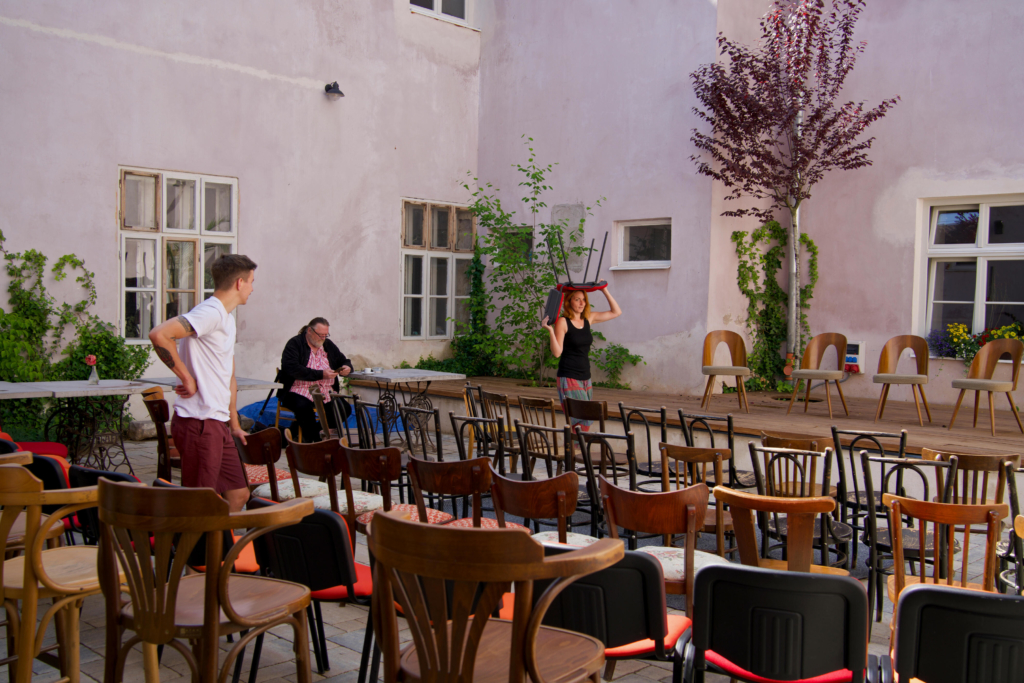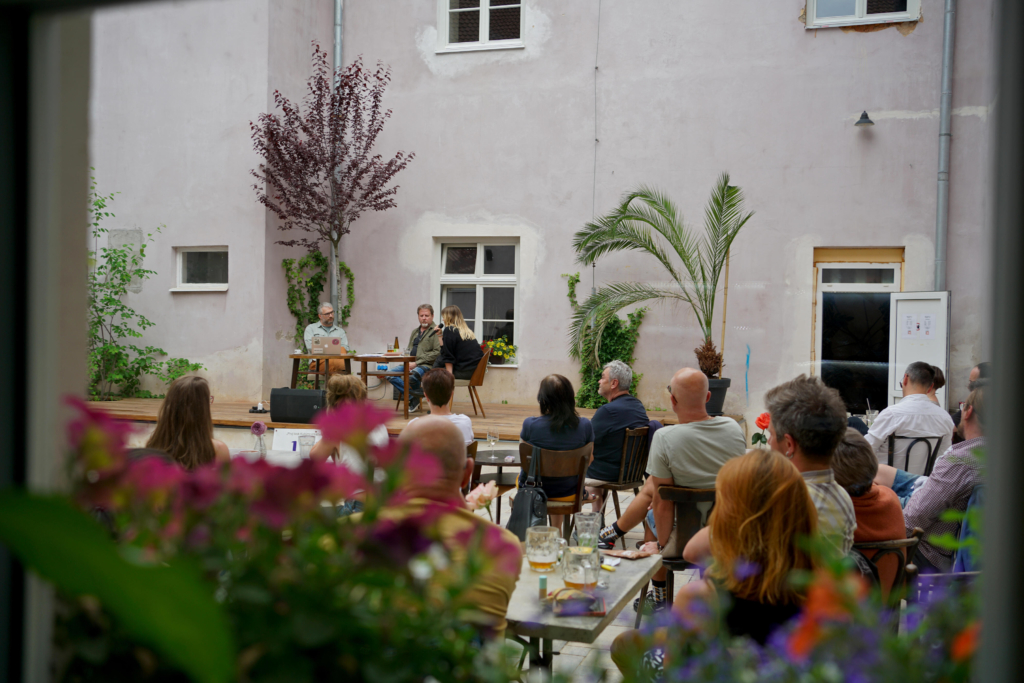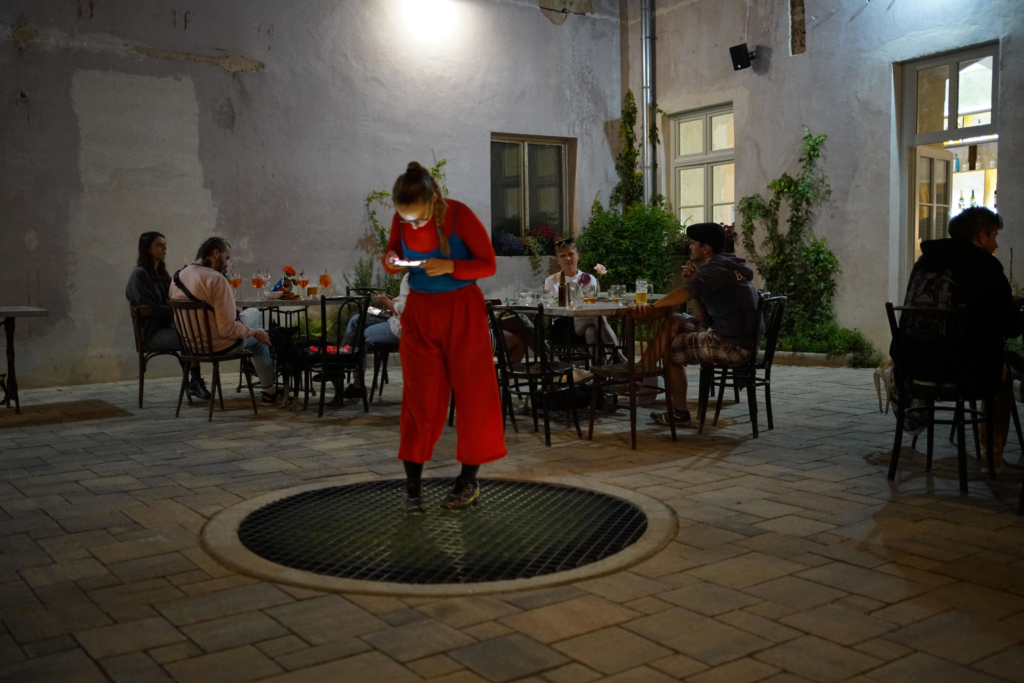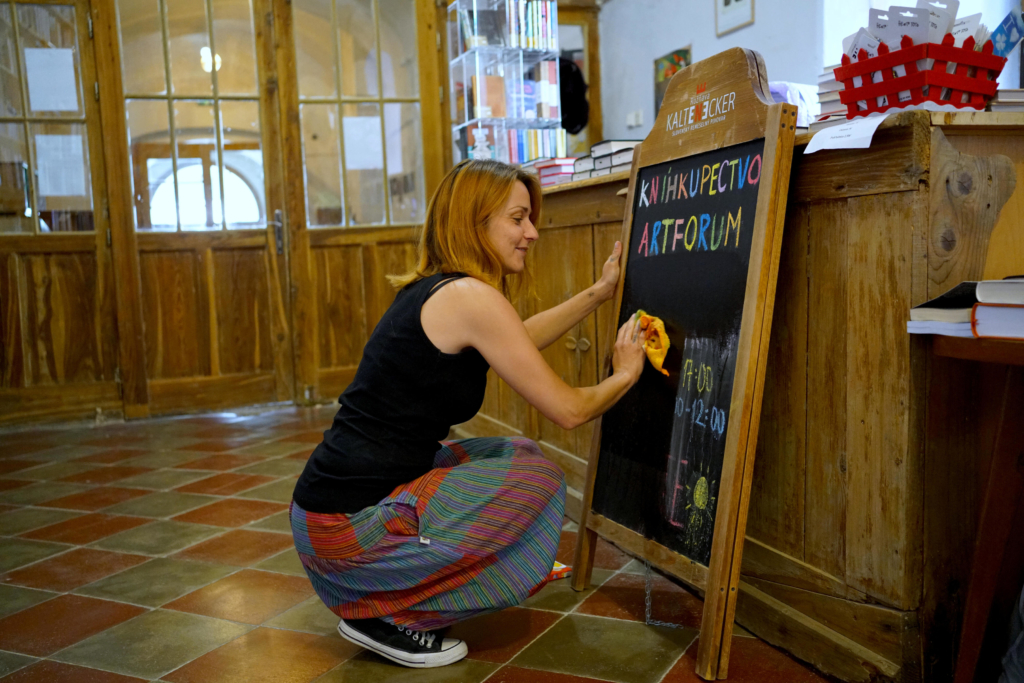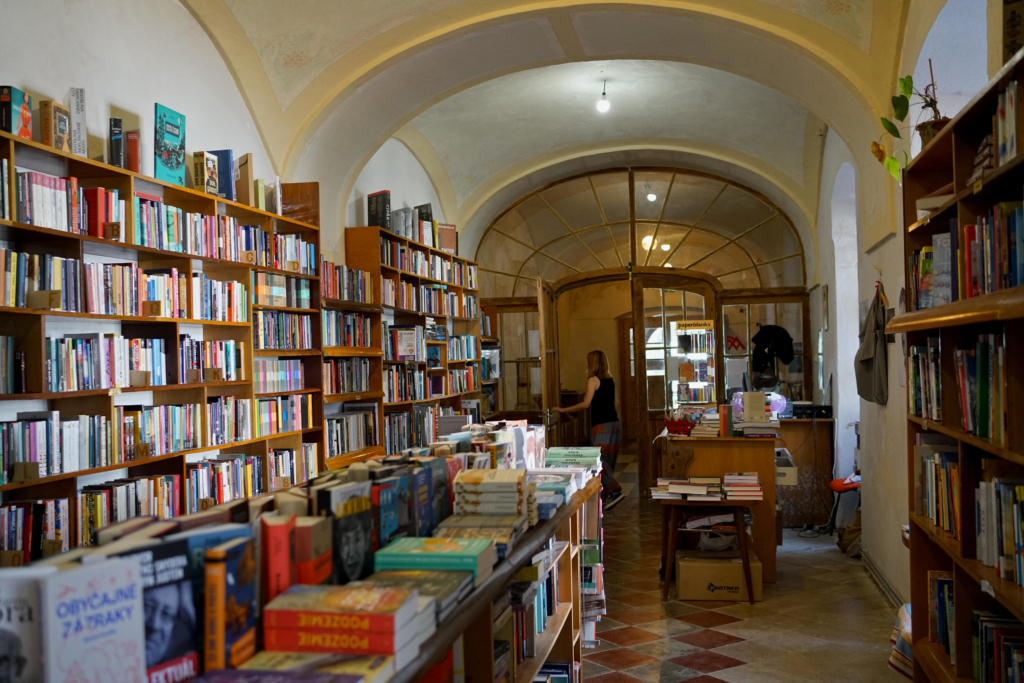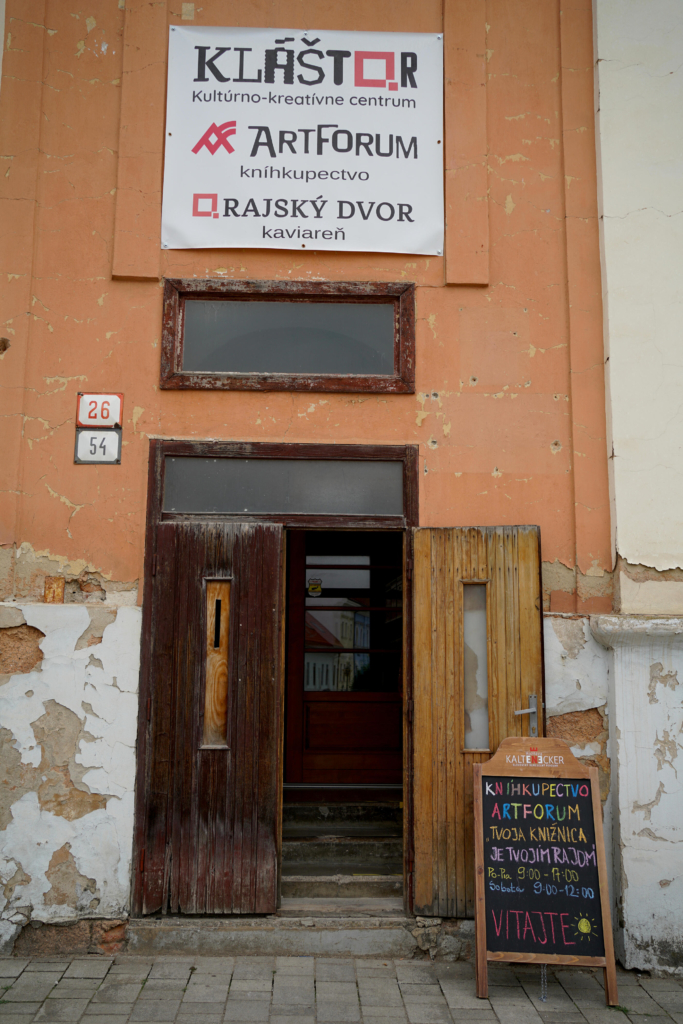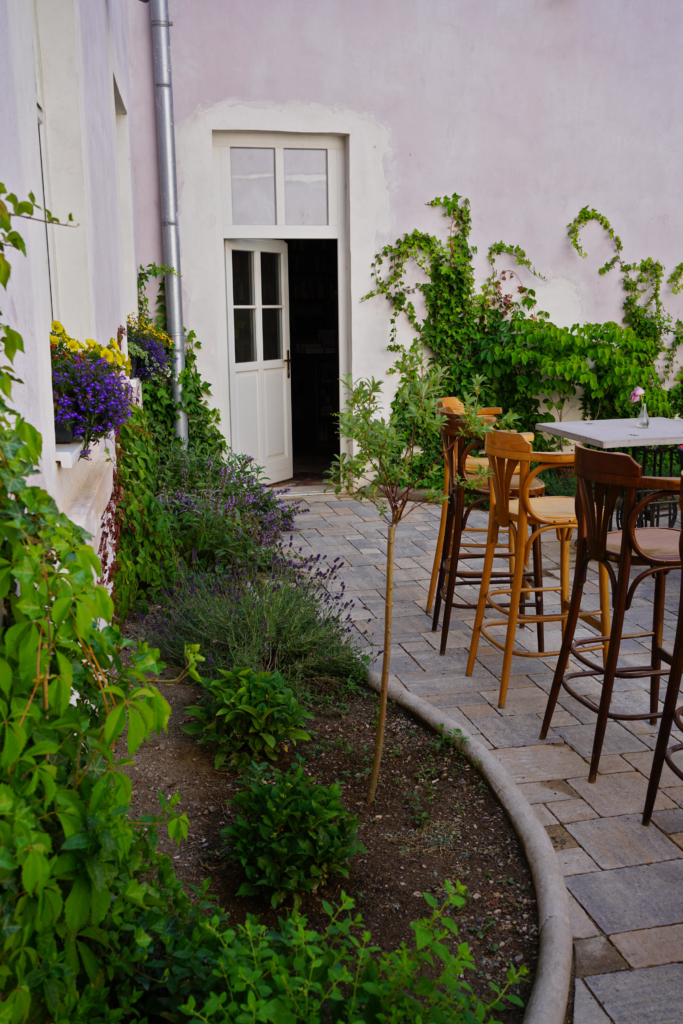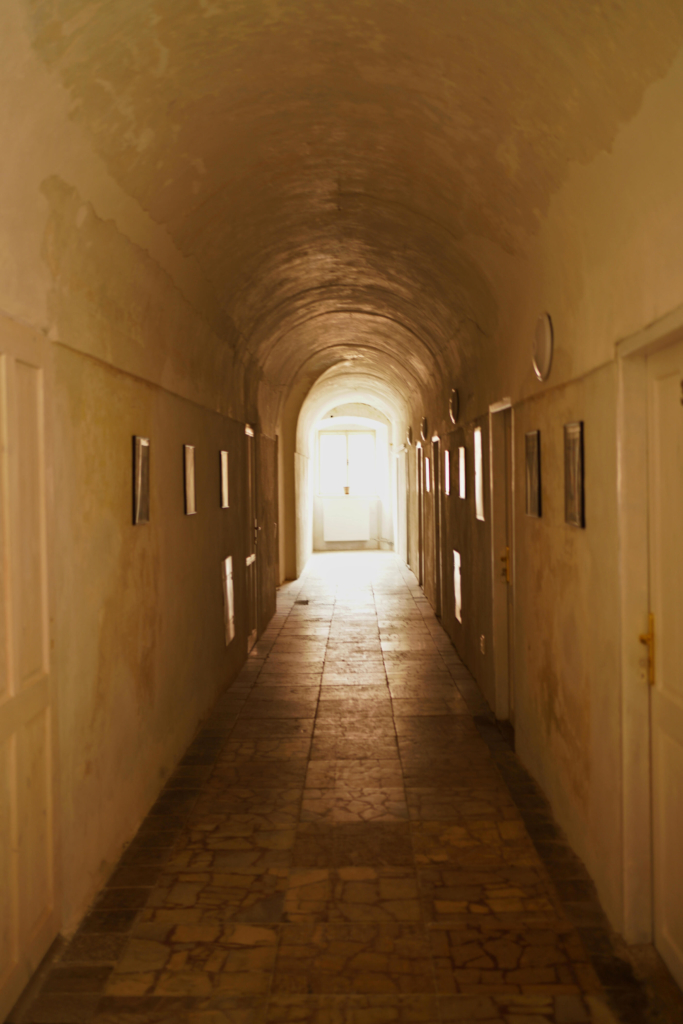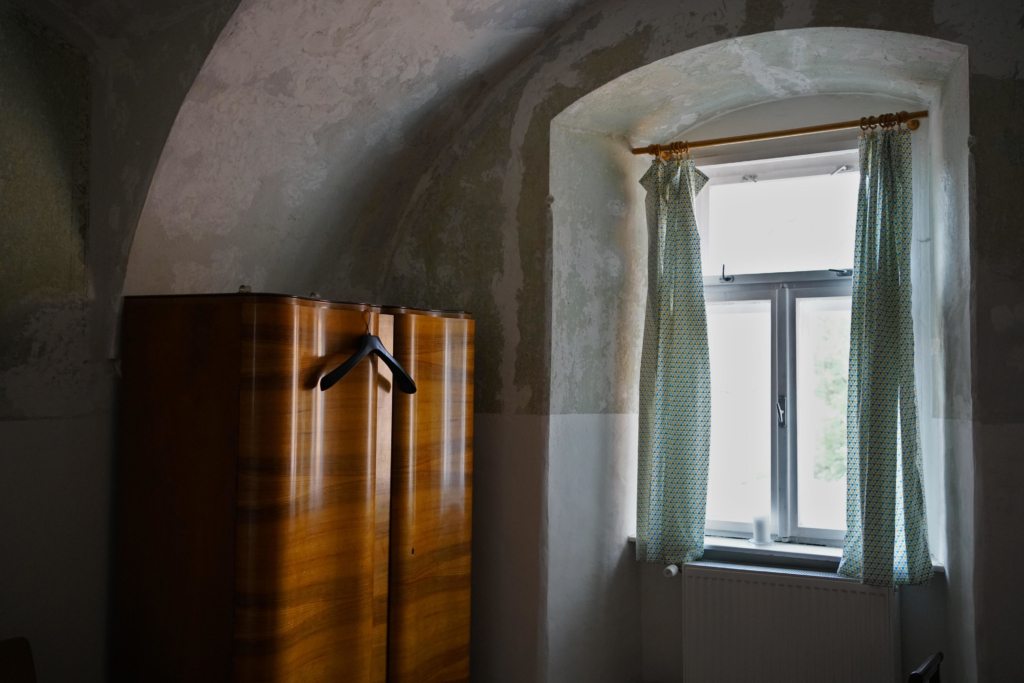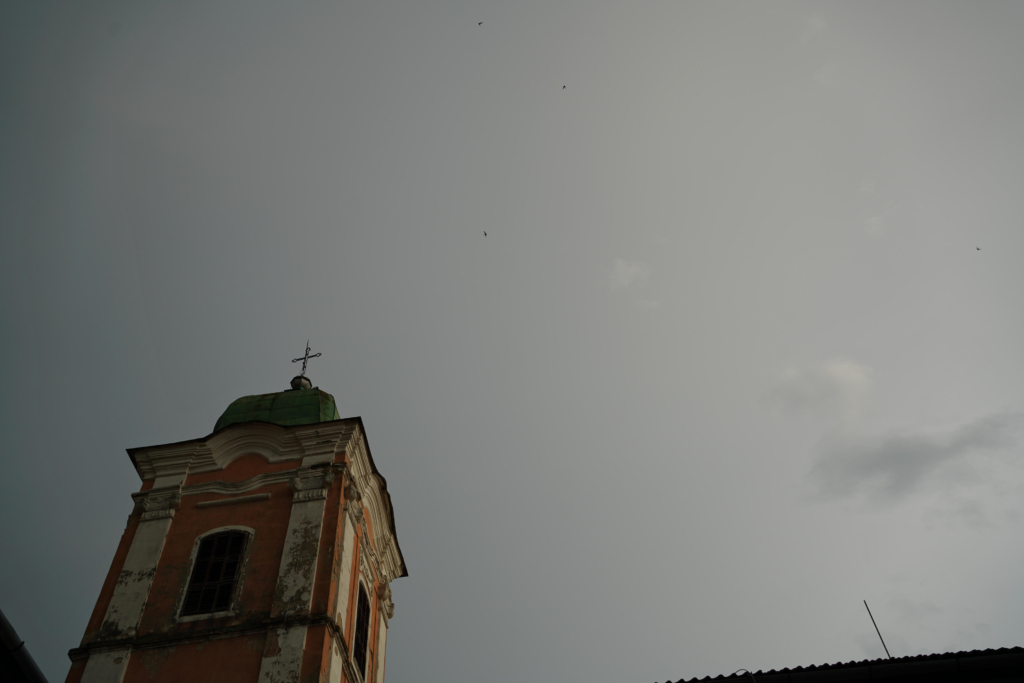The cultural and creative center Kláštor in Rožňava is an inspiring new hub of the Gemer region
The Art of caring about the place we live in
Morning. Silence. Gong. Choral singing in Hungarian is slowly, gradually filling the space. Rather ceremonial, festive feeling of the morning. The light on the sheets is still fresh when I wake up in the room at the very end of the corridor, the wall of which is shared with the church. The Monastery building thus remained in the only physical contact with its purpose from three centuries ago. Kláštor means Monastery in Slovak.
Today, the main essence of the space is an active community, dialogue, and actions to make things move well, to move them well: „We founded the Kláštor with that in mind. Cultural events are one thing, but the reason we created the civic association and everything else is for people to actively approach their city and their life,” Szeko begins our conversation.
In 6 years, what did they manage to start up, renovate, and revive, and who did they connect with? How did it feel to start taking care of thousands of square meters and breathe new life into them?
The cultural and creative center Kláštor is the people. Warmhearted ones. It is Szeko, the restorer – and therefore, naturally, he also led the reconstruction works at Kláštor. It is also Miriam who worked at the court. Here she is a bookseller and takes care of payroll and accounting as well. Co-founder and friend Rado, a teacher of civics and Slovak language outside of Kláštor, is now in charge of reading events. Ela, a sociologist with experience in the third sector, is now on maternity leave. Rišo runs the audiobook studio Šarkan, and he’s in charge of accommodation in Kláštor. Bobo is sound engineering and does various other things. Then there is Dany and Nano overseeing the bar, Nano also taking care of events and lighting. Peťo, Monika, part-timers, friends, family. They don’t have to care about the human, gentle aspect of the space. They’re creating it simply by being as they are.
In 2016, when they started renovating the Kláštor together, they had the opportunity, as they say, to merge with the space, to debate. „Those were very nice times. In a way, I miss it. But we’re happy that now people and visitors can be here – in the end, this is what we all prepared for and wanted prior to this moment. Back then, we had such a world to ourselves. Many people didn’t know that something was happening here, that we were doing this, renovating it on a daily basis step by step. My son also came to help us – I told him that he would get 10 cents for each tap on the wall. I think he needed 2 euros at the time,” Miriam smiles.
In the older photo, they are sitting with notebooks and papers. In the only room with heating, they had to wear warm jackets anyway. With the help of friends and Čierne Diery, they managed to raise money for the boiler.
The cultural-creative center Kláštor is also a space. Readings, dance performances, and quizzes are held under the vaulted ceiling in the refectory, the room in which this group uncovered a beautiful depiction of the Last Supper. Chamber concerts, those energetic ones, melancholic and rap concerts too. At this very moment, The MimoOs company is drawing the atmospheric story with their movement, dance, facial and body expressions – what genetic patterns have our grandmothers interwoven into our bodies? What did they want to talk about, and what could they talk about? They are accompanied by Katarína Máliková’s captivating music as we perceive them in stunning red-blue lighting.
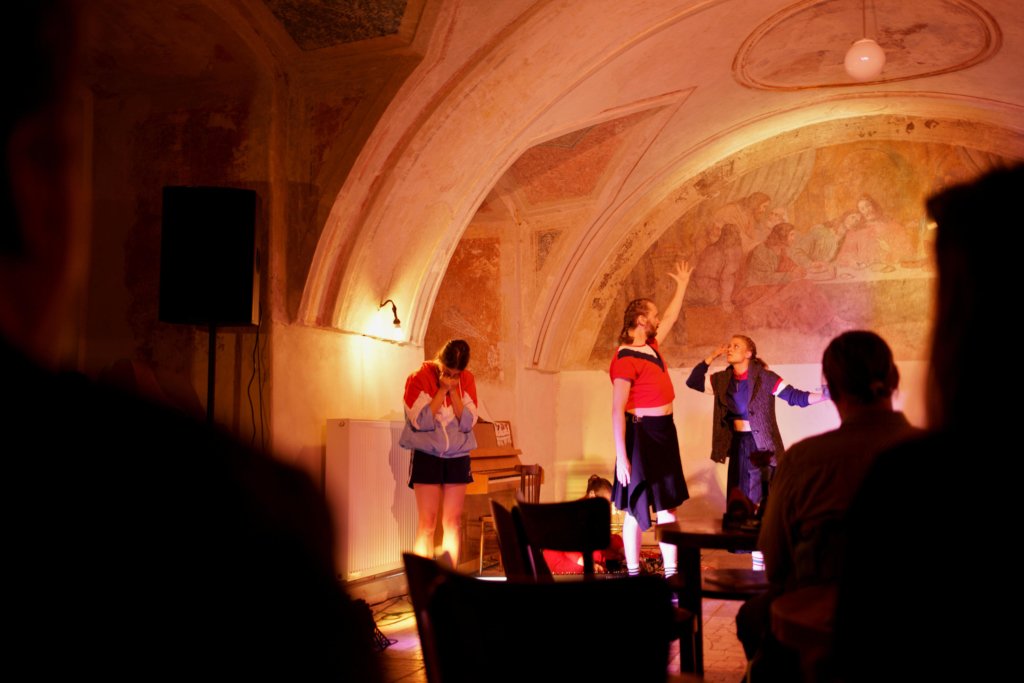
If you go through the bar, past the reading room, you arrive at the courtyard. In the Rajský dvor or Paradise Court (as the monks used to call it, and it used to be in every monastery), in good weather, people read, play, talk, sing, and work. Today it is almost full, and Balla, Kali Bagala, Nikol Hochholczerová are reading and discussing their work here. The light falls on the tower that can be seen every minute of the day through the square-shaped view of the yard. People sit at tables and the evening breeze. There used to be ivy so dense that they rolled it up like a carpet when digging under the concrete when they were uncovering the original layers. After one winter snowfall, the flakes lined up in the outline of a circle, and thus a 15-meter well was found in the center of the courtyard. Many thoughts, debates, and laughter, resounding in its evening lighting, happen when looking into its depth.
Then, you go either to the bookstore or the first floor, with coworking and with rooms for businesses and initiatives with social value. They’re currently in the process of getting booked and occupied. And last but not least, the accommodation, i.e., exactly five rooms and two apartments for guests, tourists, performers, and artists. Sometimes you can also meet students from Tono Čierny studio at the Academy of Fine Arts and Design in Bratislava who are doing research on the Gemer region. Until recently, the Ukrainian language could be heard here since families in need took shelter from March to May.
In Artforum
„We used a scalpel to scrape and rub off the individual layers,” Miriam implies a small movement on the wall with her hand. Ever since she can remember, she has wanted to own a bookstore. Her mother was a librarian at the local library. Here, it came true for her.
„I was pleasantly surprised that our customers are very interested in historical books, art, and architecture. But also literary reportages and books by Absynth publishing, people are really pleased with the selection we have. I also ‘urging’ a bit and recommend Slovak fiction to customers, for example, Ivana Gibová and others. In my opinion, students should have the opportunity to read contemporary Slovak fiction in schools, and they would be able to relate so much better to portrayed situations and to the language that is closer to them. And not start straight with Crime and Punishment.”
As she says, there are days and days, some days few people come, other days more: „Most of the time they are really nice, they cheer for us, and they are in awe of how we have transformed it here. If I have time, I guide them a bit and show them around the space. We still have quite many people in Rožňava who come here for the first time and don’t know about us.”
Meanwhile, a high school teacher stops by the bookstore, pleased that she can find books for older Ukrainian children and youth. There is a reading and discussion for high school students happening in the yard simultaneously, another customer orders Václav Pankovčin’s Marrakesh, others come to ask about some kind of Bible quiz. Because of the proximity of the church and the former function of the monastery, some think that this function didn’t change. „But we don’t have priests here,” Miriam replies patiently to the gentleman who asks about one.
It begins with an active citizen
„Without the project of the Ministry of the Interior, called Effective Public Administration, which was almost tailor-made for us, and without the local Labor Office, we wouldn’t get anywhere. It helped us so much. Regions are sometimes underestimated in terms of what people are and are not interested in. When Radko and I were organizing Rožňava’s radials for five years, even before the KC Kláštor days, it was of no surprise when 100 people often came to see an exhibition. We were also organizing a small Gemerský trh, Film Europe screenings. We really enjoyed it and wanted to either make a cafe or, in short, to find some space for such events. At the Monuments Board, they recommended that we come to see this monastery. Excuse me, thousands of square meters? Well, we went to pick up the key. Nobody wanted that building. It was the spring of 2015.”

The city wanted them to submit their official plan in the fall of the same year. They also agreed that if they fail to restore 50 % within five years, they will return Kláštor to the city. They wanted to have a deadline themselves. In the end, they exceeded the plan. By a lot: „It’s bizarre that everything we planned back then worked out, and we did it almost exactly according to plan. Or we are also stubborn. Fortunately, changes happen slowly, so we manage to adapt – however, I’m not sure if we manage to be sufficiently open to new ideas, to step out of our rut, I hope so. Thank God we are very lucky with people, including Eugene, the financial manager, he helped us a lot, and now he is coming back to us after a break. And the second or first thing that helped us enormously was the aforementioned Effective Public Administration. It was 270 thousand euros, of which we could use 40% for flat costs. We did approximately 50 workshops on civic activism, how municipalities work, and on greenery. I learned a lot of things there.
I was working at the mining museum at the time, wanted to employ six people in Kláštor, full or part-time, through the Labor Office, where the clerks were very nice and helpful. They cheered us on and helped us fill out the forms in the beginning. We were also lucky in every single office for clerks. We have had several financial crises, but they have never been fatal. When the payroll budget dropped, we scaled back.”

Plans and community
„We would like to encourage Rožňava citizens to visit us and have a person in the team who would be in charge of working with the local community, someone who would really enjoy it. Young people don’t know much about us yet, but their friends will come here through our part-timers, and it gradually spreads.” For example, the pub quizzes are almost always completely full, and the reading events are also pleasantly populated. What are their plans and desires for the foreseeable future? Szeko continues:
„It seems to me that there are still very few of us in the team, and there is a lot of work to be done. We need to sublease all the rooms so that they are occupied. Have a stable income, set it up financially, and cover overhead costs so we can be at peace. And take three more people to our team. Implement a gastro – something simple to go with beer and also meals for those who will be staying here, i.e., Bed and Breakfast. And above all, to have satisfied people, so that they enjoy the work, I really wish that. We would still like to start art residencies and site-specific installations. Gradually.”
Like a whirlwind of energy going around, there comes Nano. He promised Pudding Mrs. Elvis, a Slovak band, soup and food, although they are not cooking yet in Kláštor. That’s how they are. They want to meet halfway whenever possible: „I’ll make hummus, real Hungarian way – it will sting their eyes from the spiciness!” I still have to ask about this. What Nano cooked for them in the end.
Szeko replies about how they are doing right now: „It’s all hectic. But good. Things took off. And it is also going in a good direction in terms of people’s interest in the place where they live, in active citizenship. In the ten years that we have been ‘on the scene,’ things are getting better. It’s a little bit, but you can work with it. The mayor also helps. It’s nice when it’s also encouraged from above. We are planning another project for participation – so that people and officials from the city and the municipality can come here to learn at various workshops and lectures. Maybe if more of them came, it would have more impact.”
Soft interventions and funding models
There are many abandoned buildings in Slovakia. One of the interesting initiatives to cover the missing funds for the restoration of monuments is taking shape in the so-called Ministry of Soft Interventions. Two beautiful apartments renovated by Sadovsky architects are newly available for accommodation in Kláštor.
„Gábor Bindics came up with this so that the pilot project could be done in Kláštor. He is collaborating on this with the Bystriny initiative – Lucia Pašková, Zuzka Wienk – and others. The point is that, for example, five investors provide 10,000 euros each for the reconstruction of two apartments. Investors will have them booked for ten days, five times a year. The rest of the year, they are available to the community and tourists. This initiative should support the creation of others and that these accommodations are taken care of by locals – the monuments thus also provide work opportunities and income. After ten years, the community can decide whether to buy these apartments, whether it is worth it, and if so, the initiative of the Ministry of Subtle Interventions (whose name was invented by Ondřej Kobza, editor’s note) will use the money to buy and reconstruct other monuments.“
From the beginning, they wanted to not only connect and educate in Kláštor, but also provide job opportunities in a district and region with low employment. And connect good things so that it is not just a bubble of non-profits or ‘cultural enthusiasts’, but different spheres and professions, a diverse composition of locals and visitors from other regions (and countries).
When July 10th came, after the first wave of the pandemic in 2020, the official opening, they were pleasantly shocked with how many people came (300) and what a change it was. „For four years, you’ve been working hard with a small group of friends, and suddenly it’s here.” In Kláštor, you can already choose and book commercial, studio, or office spaces. For example, they would also like a veterinarian in a more permanently occupied space, there will also be a bike shop with a repair service or photo studio.
„Let it be as varied as possible and with a social impact.”
„Oh, a masseuse would be great!” Miriam laughs, and we start throwing in more dreamy ideas.
Send them warm regards when you are in Rožňava. Go for coffee, a trip, a concert. Maybe you’ll be woken up by singing in the room at the end of the corridor and, maybe, by the birds from the yard of room number four. And maybe, you will be delighted by the work of this group of people, who are impossible not to cherish.
Lucia Pašková from the Bystriny initiative participated in the event Cultural Policies Supported by Digital Tools organized by Creative Industry Košice in cooperation with Urban Space Lab within the framework of the Slovak-Norwegian Cultural Matching initiative supported by Iceland, Liechtenstein and Norway through the EEA and Norway Grants.
The event was also attended by: Interdisciplinary artist Grete Rockstad, co-founder of the software company Blue Lemons and the educational project Digital League Matúš Smoleň and artistic and executive director of Spriten Art Hall Tom-Erik Lønnerød.

